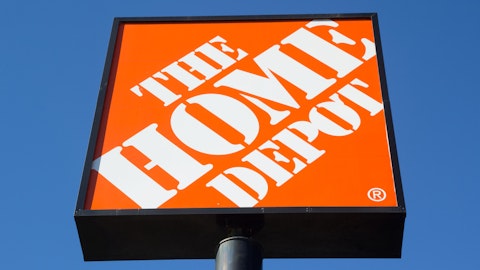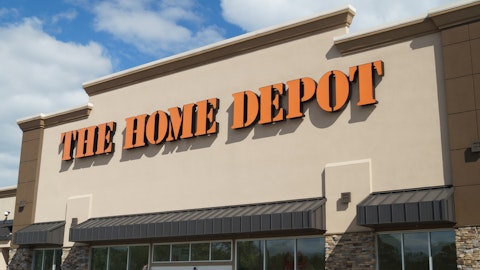Looking ahead, the company expects to add about $13 billion in total sales between 2016 and 2018 to reach its new three-year target of $101 billion in revenue. Management also targets operating margin expansion from 13% to 14.5% and an improvement in return on invested capital from 27% to 35%.
If successful, Home Depot’s sales will grow close to 5% per year over the next three years while earnings compound at a mid-teens clip. Incremental growth will be driven by Home Depot’s digital business and push to serve more professional contractors.
Home Depot estimates that its addressable market in the U.S. is $550 billion with the home improvement market accounting for $300 billion and services representing $200 billion. Maintenance, repair, and operations account for the remaining $50 billion.
In other words, Home Depot currently has about 15% market share in the U.S. and sees room for continued expansion, particularly in services (less than 3% market share), online sales (just over 5% of company-wide sales), and business with professional contractors.
Home Depot will likely remain a force for a long time.
Key Risks
Over short periods of time, Home Depot’s business is sensitive to U.S. GDP and the housing market.
Home prices began rising in 2012 and have since increased nearly 30%, according to the Case-Shiller Home Price Index. Home prices are still a bit below peak prices, but the wind has been behind Home Depot’s back for several years.
Higher home values cause homeowners to view their homes as an investment rather than an expense and have helped housing turnover return to its normalized rate, resulting in higher purchases of goods and services from home improvement retailers.
To this point, Home Depot says that big-ticket transactions over $900 in value have grown every quarter since the second quarter of 2011. Home Depot has also more than recovered the $13 billion of sales lost during the last recession.
While an unexpected slowdown in the economy and/or housing market would potentially hurt Home Depot’s near-term earnings, these events have little bearing on the company’s long-term earnings potential.
The bigger risks facing Home Depot are changing demographics, evolving customer shopping preferences, and potential market saturation.
For the first time ever, more Americans 18 to 34 years old live in their parents’ house (32.1%) than with a partner in their own home (31.6%).
It’s difficult to say what impact the Millennial generation’s different housing choices will have on the home improvement retail market, particularly if Millenials continue brining the home ownership rate lower.
Another demographic risk could be that the aging population shifts a lot of work from do-it-yourself customers to professional contractors. However, Home Depot already generates about 40% of its sales from contractors and is positioning itself for this trend by readjusting its organization to have a group dedicated on solving the needs of contractors.
Perhaps the biggest uncertainty facing all brick-and-mortar retailers is the rise of e-commerce and how customers shop. Home Depot has said that close to 60% of customers now start their buying journeys online before they even enter a Home Depot store.
Consumers can now buy virtually any product they desire using just the phone in their pockets – there is no longer as great of a need to visit huge stores to find what you need.
In other words, store size is not quite the advantage that it was 10 years ago, potentially creating opportunity for lower-cost internet retailers to begin stealing market share.
Home Depot has long been taking steps to fight off potential e-commerce competition. The company’s digital business has nearly tripled in the last few years and now accounts for over 5% of total company-wide sales.
Home Depot is fortunate to participate in many product categories that are less susceptible to online competition, in my view. Many products sold by home improvement retailers are for unique projects that require a hands-on evaluation and some consultation.
For example, a do-it-yourself remodel project requires the consumer to review paint colors, flooring designs, cabinet options, and more. Figuring out all of the materials needed is also difficult.
Home Depot’s online store is a major help and interconnects with its brick-and-mortar operations. According to Home Depot’s 2015 annual report, over 40% of the company’s online orders are picked up inside of a Home Depot store.
With more than 2,200 store locations across North America, Home Depot is better able to provide customers with omni-channel convenience compared to its smaller rivals.
Home Depot’s scale also gives it a leg up in e-commerce. The company has three massive direct fulfillment centers across the country that allow it to reach most of its U.S. customers in two business days or less when shipping directly to a home or job site.
Once again, smaller rivals cannot afford to make these investments, strengthening Home Depot’s hold on the number one market share spot.
Aside from demographics and changing customer preferences, market saturation is probably the biggest risk challenging Home Depot’s long-term earnings growth trajectory.
It’s hard to say how many big box home improvement retailers the country needs. Home Depot’s efforts to expand its addressable market into services and MRO markets (e.g. its $1.7 billion acquisition of MRO player Interline Brands last year) could be an indication that growth opportunities in traditional home improvement are nearing capacity – especially given its status as the largest player in the market.
Overall, Home Depot doesn’t appear to face many critical risks. Its strong brand, massive store base, economies of scale, leading e-commerce operations, and valuable real estate will keep it relevant and generating cash for a long time.





